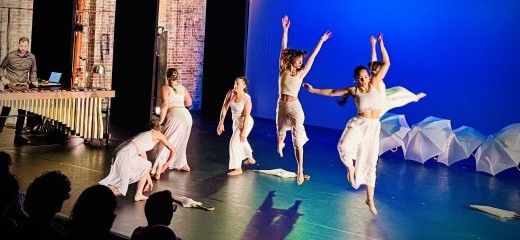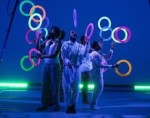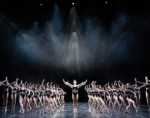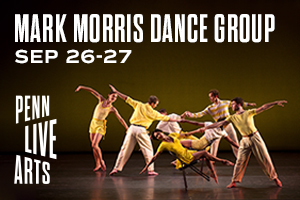
Pas de Umbrella: On Weathering the World with Whimsy
by Lauren Berlin
On a rainy June evening, an audience slips into the Performance Garage—a vaulted brick hideaway. Inside, Anne-Marie Mulgrew and Dancers Company offers something zany, charming, and gently provocative: Chapter 39 with Grit, Grace, and Whimsy. Mulgrew, celebrating the company’s 39th year, has always had a gift for weaving the sprightly with the poetic, blending the offbeat, the surreal, and the heartfelt into something distinctly her own.
Chapter 39 features five dances–two dance films and three live premieres that balance playful absurdity with moments of nostalgia and bold experimentation. Quartet for the Living–which is presented in two parts–pulses with energy, set to the industrial rhythms of “Warehouse Medicine.” Solo for 4 blends intimacy and theatricality, unfolding to the layered string textures of Zoë Keating’s "The Last Bird" and the romantic sweep of pianist Paul de Senneville’s "Mariage d'Amour." In Improvisation for the Future, a 20-minute dance-theater collaboration with percussionist Andy Thierauf, the performers navigate a terrain of risk, rhythm, and raw invention. Together, these works reflect the company’s evolving identity while inviting the audience into a world where imagination, emotion, and play take center stage.
In Quartet for the Living Part 1 and Part 2 (2024/25), the ensemble is dressed in sleek black, moving with a captivating blend of discipline and abandon—at times precise and sculptural, at others loose and swingy. The choreography shifts between geometric sharpness and moments more Isadora Duncan than Martha Graham, leaning fully into spontaneity: head rolls, twirls, limb-flung spirals, yogic tree poses held just long enough to teeter. Think leap, hop, clap, bounce, skip, chase—the vocabulary of childhood. Then there is the spontaneous, unfiltered burst of laughter from the performers–a collective nervous system reset. The dancers feed off each other’s energy, their movements loose, flailing, perfectly timed in their shared kookiness. It is slap-happy and alive, the kind of laughter that needs no punchline—just presence, permission, and a little chaos.
But nothing quite captures Anne-Marie Mulgrew’s tender eccentricity like the mixed-media dance film, Tales of the Buffoon (1992), a collaboration with visual artists Mitchell Taylor Gillette and Claude White. There’s inspiration from Russian folklore—namely the skomorokh, the medieval clown-musicians who satirized society with songs, stories, and mischief. Like the harlequin in Commedia dell’arte or Japan’s kyōgen comic relief, the Russian buffoon is part of a long lineage of fools who reveal uncomfortable truths by way of absurdity. Think Wee Sing in Sillyville meets Ballet Russes on acid. Scored with Prokofiev, the piece green-screens its dancers into a black-and-white, pen-and-ink cartoon world—populated by oddball characters, surreal gestures, and comic plot points involving trickery and, yes, goat murder. Part slapstick, part constructivist hallucination, and wholly sincere, Tales of the Buffoon doesn’t mock the ridiculous—it honors it.
Frances (2017) is for anyone who grew up dancing down stair railings, ducking under docks, or inventing musicals in a bathrobe cape. One short film captures a dancer navigating a narrow wooden staircase, her boots clicking like a percussionist’s metronome, using the handrail as a duet partner. The dancer slinks and side-steps with kinetic cleverness that feels familiar and fresh, reminding us how a railing once became a barre, a stair, a stage, and a creaky house–a limitless playground for imagination.
In Improvisation for the Future, six dancers spin, dart, and dash with stark white umbrellas, lifting them skyward with such rhythmic devotion that for a moment, you believe they might actually take off: run, run, run–gasp, run, run, run. The umbrellas serve as kites, propellers, and partners. That giddy, improvised twirl—remember your younger self alone in the living room at age seven, declaring “Look at me! I’m flying!”—is resurrected here with total sincerity. And that’s the point: Play, at its best, is radical in its refusal to perform.
As the dancers move to the bright, bouncing tones of a live marimba, I’m transported to the ’90s—pre-9/11—when that wooden, percussive sparkle was everywhere.
A quietly powerful motif runs through Mulgrew’s repertoire: movement that feels instinctive, unscripted, unburdened, and playfully alive. A staircase becomes a stage. A cartoon kitchen becomes a universe. In her world, the absurd is elevated, the risible is revered. And in that freedom—unguarded, curious, a little chaotic—we return to the purest form of creativity.
39 is a reclamation of the wild, exuberant child still flickering within.
After the show, in the soft rain, I think of Anne-Marie Mulgrew—not just as a choreographer, but as a kindred spirit. Thirty-nine years in, Mulgrew’s work transcends a world that often forgets how to play—a world that has become more digital, more distracted, and more disillusioned. Instead, Mulgrew reminds us that grace can be unruly, grit can be tender, and whimsy might just be the point.
Not every choreographer can hold all three in a single breath—but she’s been doing it for nearly four decades, and she’s not done yet.
**The cast features longtime collaborator Leslie Ann Pike, marking her 14th year with the company, and founding member Joe Cicala, who returns from retirement for a rare appearance in Improvisation for the Future. They are joined by dance artists Shelby Bakota, Jasmin Cicchino, Nerissa Tunnessen, JA Kirk, and India Scott.
Chapter 39 with Grit, Grace, and Whimsy, Anne-Marie Mulgrew and Dancers Company, Performance Garage, June 27, 2025
Homepage Image Description: One dancer is elevated in a supported position while others provide grounded bases for a lift, demonstrating coordinated weight-sharing and balance. The movement highlights contemporary partnering, spatial precision, and controlled transitions.
Article Image Description: In Mulgrew’s premiere, Improvisation for the Future, dancers Shelby Bakota, JA Kirk, India Scott, Nerissa Tunnessen, Jasmin Cicchino, and Leslie Ann Pike, alongside percussionist Andy Thierauf, blur the lines between sound and movement in a spirited performance. Umbrellas become central props—sometimes statues, sometimes partners—adding elements of surprise and stillness to a piece rich with playful energy and shifting roles.
By Lauren Berlin
July 13, 2025










